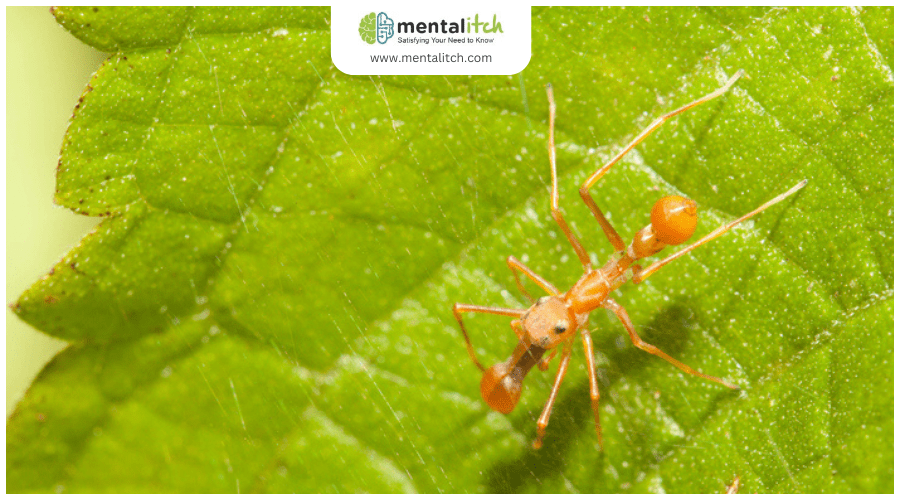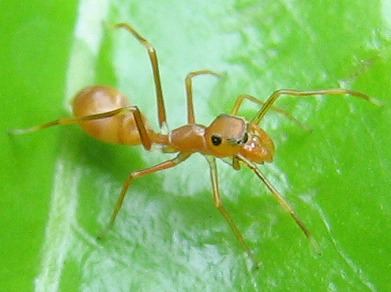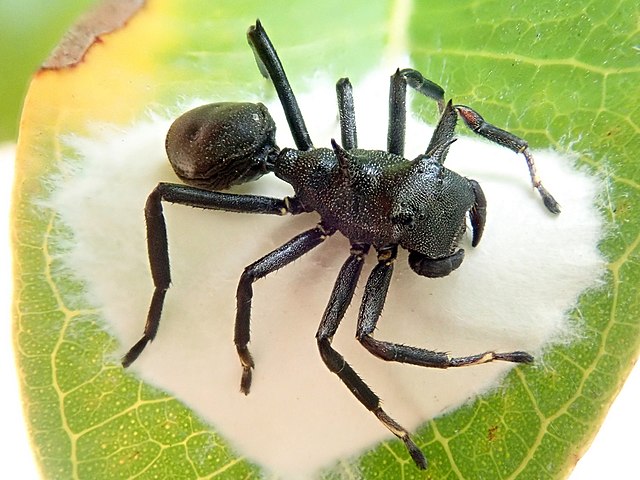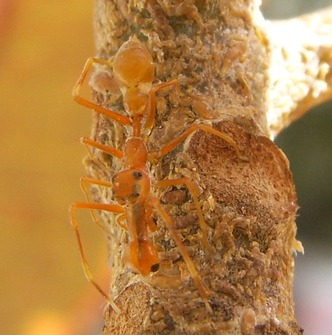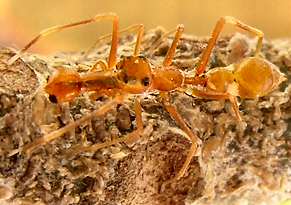It is fascinating to learn how Myrmarachne plataleoides, a jumping spider, has perfected the art of disguise to mirror the weaver ants it coexists with. You’ll find that this spider doesn’t just mimic the ants’ appearance in size, shape, and color but goes a step further by adopting behaviors and physical adaptations that are remarkably ant-like, from mimicking the ants’ movements to having body constrictions that give it an ant-segmented look.
The question you might be pondering is, how does this intricate form of mimicry benefit Myrmarachne plataleoides in its natural habitat? The answer lies in a blend of survival strategies that are as cunning as they are fascinating. Let’s explore this spider’s world, where appearance is more than just surface deep.
Physical Appearance Mimicry
Myrmarachne plataleoides masterfully mimics weaver ants, matching their size, shape, and color to ward off predators. This spider’s physical appearance is so finely tuned to resemble its ant counterparts that it’s often hard to tell them apart at first glance. The mimicry doesn’t stop at mere size and color; the spider’s body has distinct constrictions that cleverly create the illusion of an ant’s head, thorax, and gaster. This level of detail in mimicry guarantees that predators often mistake them for the less palatable weaver ants.
Black patches on the spider’s head further enhance this mimicry, imitating the large compound eyes of weaver ants. This attention to detail in physical appearance is important for Myrmarachne plataleoides to successfully deter predators. For females, the front legs are modified to resemble weaver ant feelers, adding another layer to their disguise. Meanwhile, males take this mimicry a step further by resembling a larger ant carrying a smaller one, thanks to their elongated chelicerae. This intricate mimicry not only helps in avoiding predators but also highlights the incredible evolutionary adaptations of Myrmarachne plataleoides.
Behavioral Adaptations
Beyond its physical resemblance to weaver ants, Myrmarachne plataleoides employs a variety of behaviors that further enhance its mimicry, tricking predators into thinking it’s an ant. This jumping spider has mastered behavioral adaptations that are pivotal to its survival strategy. By mimicking ant behaviors and appearance, it engages in Batesian mimicry, a tactic where a harmless species imitates the warning signals of a harmful one to avoid predation.
Among its mimicry tactics, leg waving stands out. This action mimics the antennal movements of ants, making Myrmarachne plataleoides even more convincing as it walks among them. Moreover, it only jumps when threatened, a behavior not common among ants but essential for the spider’s escape strategy.
Another fascinating adaptation is its ability to steal from ant broods and absorb colony smells. These actions ensure it blends seamlessly with the ant population, enhancing its ant-like characteristics. By avoiding direct contact with weaver ants yet closely mimicking them, Myrmarachne plataleoides cleverly uses Batesian mimicry to its advantage, making sure predators are less likely to target it. This blend of mimicry tactics cements its place as a master of deception in the natural world.
Batesian Mimicry Strategy
In harnessing Batesian mimicry, Myrmarachne plataleoides skillfully deceives predators by adopting the guise of weaver ants, a strategy that greatly enhances its survival odds. This spider, lacking the ants’ defenses, benefits immensely as predators steer clear due to the uncanny resemblance. You see, Batesian mimicry is all about guarantee. By mimicking a more dangerous or unpalatable species, Myrmarachne plataleoides guarantees its protection without needing venom or a bad taste.
This mimicry strategy is not just about looking the part. The spider also imitates the weaver ants’ behavior and coloration, perfecting its act to thrive in environments where these ants are present. It’s a clever ploy, leveraging the fear predators have of weaver ants to its advantage. The result? A significant boost in survival rates for Myrmarachne plataleoides, allowing it to flourish where others might falter.
Aggressive Mimicry Tactics
While Batesian mimicry provides Myrmarachne plataleoides with a protective guise, its use of aggressive mimicry tactics further amplifies its survival strategies by enabling it to hunt unsuspectedly. By imitating both the anatomy and behavior of weaver ants, Myrmarachne plataleoides masters the art of deception. This spider doesn’t just look like its ant counterparts; it acts like them, blending seamlessly into their environment. This cunning adaptation allows it to approach prey and predators alike without raising alarm.
Aggressive mimicry isn’t just about looking the part. Myrmarachne plataleoides takes its masquerade a step further by releasing toxic chemicals. These chemicals mimic the alarm pheromones of weaver ants, adding another layer to its disguise. This sophisticated strategy not only protects the spider from becoming a meal but also aids it in hunting. Its prey, deceived by the spider’s ant-like appearance and behavior, fails to recognize the danger lurking in plain sight.
This advanced form of mimicry showcases Myrmarachne plataleoides’ incredible adaptation for survival. Through aggressive mimicry, it navigates the challenges of its environment, turning potential threats into opportunities. This spider’s life is a demonstration of the power of adaptation and the lengths to which nature will go to ensure survival through deception.
Ant Mimicry Across Ages
Juvenile Myrmarachne plataleoides expertly mimic different ant species at varied growth stages, greatly boosting their chances of survival. This intriguing spider, known for its keen mimicry, adjusts its appearance through molting stages to resemble various ant species, a proof of its remarkable adaptive abilities. As you observe these Myrmarachne jumpers, you’ll notice that their mimicry strategies are not static. Instead, they evolve, demonstrating an intricate understanding of the ant mimicry necessary for their survival at different developmental stages.
The ability of Myrmarachne plataleoides to adapt their mimicry across ages is fascinating. From their juvenile phase to maturity, these spiders fine-tune their survival tactics, constantly updating their mimic strategies to align with the specific ant species they aim to imitate. This dynamic approach to mimicry ensures that Myrmarachne jumpers are always in sync with their ever-changing environment, making ant mimicry a critical component of their survival toolkit.
Their life cycle is a parade of mimicry marvels, showcasing how these spiders leverage their surroundings and their intrinsic adaptive abilities to thrive. By imitating various ant species throughout their growth stages, Myrmarachne plataleoides master the art of survival through mimicry, a skill honed across ages.
Habitat and Diet Influence
Exploring how Myrmarachne plataleoides adapts its diet and selects habitats reveals the depth of its survival strategies through mimicry. Living among trees and bushes frequented by weaver ants, this spider cleverly integrates itself within ant colonies, gaining protection and access to a diverse menu. Its diet is primarily made up of insects like flies and grasshoppers that share the ant-dominated territories, illustrating a strategic choice in prey sources that aligns with its mimicry tactics.
Understanding this spider’s habitat and dietary preferences is key to appreciating its evolutionary adaptation. It’s not just about looking like an ant; it’s about living like one, too. By mimicking weaver ants, Myrmarachne plataleoides not only avoids predators that shy away from the ants’ painful defenses but also secures a food source within the protective environment of the ant colonies.
| Feature | Significance | Relation to Mimicry |
|---|---|---|
| Habitat | Trees/bushes with weaver ants | Enhances mimicry success |
| Diet | Insects (e.g., flies, grasshoppers) | Aligns with ant presence |
| Predation Avoidance | Mimicking distasteful/painful ants | Survival strategy |
| Ecological Significance | Demonstrates evolutionary adaptation | Highlights mimicry as an ecological strategy |
The intricate relationship between Myrmarachne plataleoides’ habitat, diet, and its ant mimicry underscores the ecological significance of these factors in its survival.
Conclusion
To sum up, you’ve learned that Myrmarachne plataleoides masterfully mimics weaver ants through its physical appearance and behaviors. It’s not just about looking the part; it’s about survival. By adopting Batesian mimicry, this spider avoids predators, blending seamlessly into ant colonies. Its aggressive mimicry tactics further enhance its deception, proving how mimicry isn’t just an act but a vital survival strategy. Whether through appearance, behavior, or habitat, Myrmarachne plataleoides showcases the art of mimicry at its finest.
